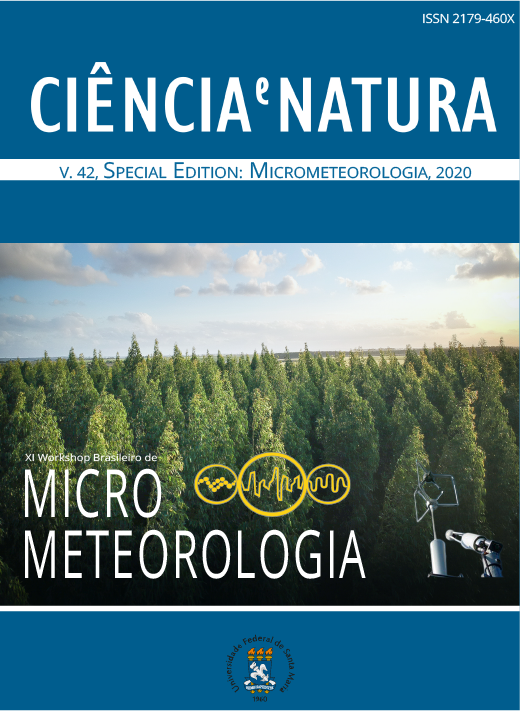Variabilidade temporal dos fluxos noturnos determinados a partir de duas diferentes metodologias no nível de 325 m acima da floresta Amazônica
DOI:
https://doi.org/10.5902/2179460X45356Palavras-chave:
Fluxos noturnos, Covariância dos vórtices, MultirresoluçãoResumo
O presente estudo teve como objetivo analisar e comparar a variabilidade temporal dos fluxos noturnos de CO2, calor sensível e calor latente, calculados a partir de duas diferentes metodologias: uma com janela temporal de 5 minutos (através da técnica de covariância de vórtices), e outra com 109 minutos (a partir da decomposição em multirresolução). Para tanto, foram utilizadas séries noturnas de 25 noites no período entre outubro e novembro de 2015. As análises foram feitas para dois grupos de padrões distintos de turbulência: um de regime intermitente e outro de turbulência homogênea. Os resultados evidenciaram que os fluxos obtidos pelo método clássico de covariância dos vórtices se mostraram dependentes da intensidade da turbulência. Por outro lado, os fluxos calculados a partir da técnica de decomposição em multirresolução apresentaram flutuações significativas na evolução temporal de todos os escalares analisados. As maiores diferenças percentuais entre as duas abordagens ocorreram no grupo de regime de turbulência homogênea, o qual teve como característica preponderante uma fraca atividade turbulenta ao longo das noites. Na comparação realizada, a metodologia empregada na janela de 109 minutos apresentou uma maior eficiência nas estimativas das trocas a 325 m na torre ATTO, principalmente durante condições de baixa atividade turbulenta.
Downloads
Referências
ACEVEDO, O. C. et al. Intermittency and the exchange of scalars in the nocturnal surface layer. Boundary-Layer Meteorology, v. 119, p. 41–55, 2006.
ACEVEDO, O. C. et al. Turbulent carbon exchange in very stable conditions. Boundary-Layer Meteorology, v. 125, p. 49–61, 2007.
ACEVEDO, O. C. et al. The influence of submeso processes on stable boundary layer similarity relationships. Journal of the Atmospheric Sciences, v. 71, n. 1, p. 207–225, 2014.
ANDREAE, M. O. et al. The amazon tall tower observatory (atto): overview of pilot measurements on ecosystem ecology, meteorology, trace gases, and aerosols.
COULTER, R. L.; DORAN, J. C. Spatial and temporal occurrences of intermittent turbulence during CASES-99. Boundary-Layer Meteorology, v. 105, p. 329–349, 2002.
HOWELL, J. F.; MAHRT, L. Multiresolution flux decomposition. Boundary-Layer Meteorology, v. 83, n. 1, p. 117–137, 1997.
HOWELL, J. F.; SUN, J. Surface-layer fluxes in stable conditions. Boundary-Layer Meteorology, v. 90, p. 495–520, 1999.
MAHRT, L. Characteristics of submeso winds in the stable boundary layer. Boundary-Layer Meteorology, v. 130, n. 1, p. 1–14, 2009.
OLIVEIRA, P. E. S. et al. Turbulent and non-turbulent exchange of scalars between the forest and the atmosphere at night in Amazonia. Atmospheric Chemistry and Physics, v. 18, p. 3083–3099, 2018.
VICKERS, D.; MAHRT, L. The cospectral gap and turbulent flux calculations. Journal of Atmospheric and Oceanic Technology, v. 20, n. 5, p. 660–672, 2003.
VORONOVICH, V.; KIELY, G. On the gap in the spectra of surface-layer atmospheric turbulence. Boundary-Layer Meteorology, v. 122, p. 67–83, 2007.
ZERI, M.; SA, L. D. A. Horizontal and vertical turbulent fluxes forced by a gravity wave event in the nocturnal atmospheric surface layer over the Amazon Forest. Boundary-Layer Meteorology, v. 138, p. 413–431, 2011.
Downloads
Publicado
Como Citar
Edição
Seção
Licença
Para acessar a DECLARAÇÃO DE ORIGINALIDADE E EXCLUSIVIDADE E CESSÃO DE DIREITOS AUTORAIS clique aqui.
Diretrizes Éticas para Publicação de Revistas
A revista Ciência e Natura está empenhada em garantir a ética na publicação e na qualidade dos artigos.
A conformidade com padrões de comportamento ético é, portanto, esperada de todas as partes envolvidas: Autores, Editores e Revisores.
Em particular,
Autores: Os Autores devem apresentar uma discussão objetiva sobre a importância do trabalho de pesquisa, bem como detalhes e referências suficientes para permitir que outros reproduzam as experiências. Declarações fraudulentas ou intencionalmente incorretas constituem comportamento antiético e são inaceitáveis. Artigos de Revisão também devem ser objetivos, abrangentes e relatos precisos do estado da arte. Os Autores devem assegurar que seu trabalho é uma obra totalmente original, e se o trabalho e / ou palavras de outros têm sido utilizadas, isso tem sido devidamente reconhecido. O plágio em todas as suas formas constitui um comportamento publicitário não ético e é inaceitável. Submeter o mesmo manuscrito a mais de um jornal simultaneamente constitui um comportamento publicitário não ético e é inaceitável. Os Autores não devem submeter artigos que descrevam essencialmente a mesma pesquisa a mais de uma revista. O Autor correspondente deve garantir que haja um consenso total de todos os Co-autores na aprovação da versão final do artigo e sua submissão para publicação.
Editores: Os Editores devem avaliar manuscritos exclusivamente com base no seu mérito acadêmico. Um Editor não deve usar informações não publicadas na própria pesquisa do Editor sem o consentimento expresso por escrito do Autor. Os Editores devem tomar medidas de resposta razoável quando tiverem sido apresentadas queixas éticas relativas a um manuscrito submetido ou publicado.
Revisores: Todos os manuscritos recebidos para revisão devem ser tratados como documentos confidenciais. As informações ou ideias privilegiadas obtidas através da análise por pares devem ser mantidas confidenciais e não utilizadas para vantagens pessoais. As revisões devem ser conduzidas objetivamente e as observações devem ser formuladas claramente com argumentos de apoio, de modo que os Autores possam usá-los para melhorar o artigo. Qualquer Revisor selecionado que se sinta desqualificado para rever a pesquisa relatada em um manuscrito ou sabe que sua rápida revisão será impossível deve notificar o Editor e desculpar-se do processo de revisão. Os Revisores não devem considerar manuscritos nos quais tenham conflitos de interesse resultantes de relacionamentos ou conexões competitivas, colaborativas ou outras conexões com qualquer dos autores, empresas ou instituições conectadas aos documentos.






